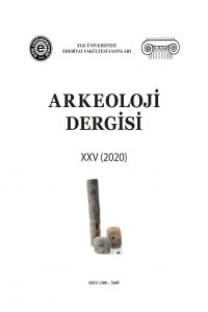Anadolu'da MÖ 3.Binyıl Minyatür Arabaları
Miniture Vehicles in Anatolia during The Third Millennium BC
___
- Akurgal 1995: E. Akurgal, Hatti ve Hitit Uygarlıkları, İstanbul.
- Akurgal 1998: E. Akurgal, Anadolu Kültür Tarihi, Ankara.
- Amiet 1980: P. Amiet, Art of the Ancient Near East, New York.
- Anlağan 1998: T. Anlağan, “Sadberk Hanım Müzesi’ndeki Bir Urartu Kemeri Üzerine Gözlemler”, Sadberk Hanım Müzesi Yıllığı, PALMET, II, İstanbul, 51-60.
- Anthony ve Vinogradov 1995: D. W. Anthony, N. B. Vinogradov, “Birth of the Chariot”, Guıde to the Western Mediterranean Archaeology, vol. 48, no. 2, U.S.A, 1995, 36-41.
- Buchanan 1981: B. Buchanan, Early Near Eastern Seals in the Yale Babylonian Collection, Yale University Press, London,.
- Darga 1992: M. Darga, Hitit Sanatı, İstanbul.
- Edgü 1983: F. Edgü (Ed.), Anadolu Medeniyetleri, Avrupa Konseyi 18. Avrupa Sanat Sergisi, İstanbul 22 Mayıs-30 Ekim 1983, Ankara.
- Foltiny 1959: S. Foltıny, “The Oldest Representations of Wheeled Vehicles in Central and Southeastern Europe”, AJA 63, no. 1, Princeton, 53-58.
- Garstang 1929: J. Garstang, The Hıttıte Empıre, London. Kulakoğlu 2003: F. Kulakoğlu, “Recently Discovered Bronze Wagon Models from Şanlıurfa, Southeastern Anatolia”, Anatolia, 24, 63-77.
- Leinwand 1992: N. Leinwand, “Regional Characteristics in the Styles and Iconography of the Seal İmpressions of Level II at Kültepe”, JANES, 21.
- Littauer ve Crouwel 1973: M. A. Littauer, J. H. Crouwel, “Early Metal Models of Wagons from the Levant”, Levant, V, London, 102-126.
- Littauer ve Crouwel 1979: M. A. Littauer, J. H. Crouwel, Wheeled Vehicles and Ridden Animals in the Ancient Near East, Köln.
- Littauer ve Crouwel 1991: M. A. Littauer, J. H. Crouwel, H. Hauptmann, “Ein Spätbronzezeitliches Speichenrad vom Lidar Höyük in der Südost Türkei”, Archäologischer Anzeiger, Berlin, 350-358.
- Littauer ve Crouwel 1996: M. A. Littauer, J. H. Crouwel, “The Origin of the True Chariot”, Antiquity Heslington, 70, 934-939.
- Moorey 1986: P. R. S. Moorey, “The Emergence of the Light, Horse-Drawn Chariot in the Near East c. 2000-1500 B.C.”, World Archaeology, vol. 18, no. 2, Abingdon, 196-215.
- Muscarella 1998: O. W. Muscarella, Bronze and Iron, Ancient Near Eastern Artifacts in the Metropolitan Museum of Art, Newyork.
- Özgen 1986: E. Özgen, “A Group of Terracotta Wagon Models from Southeastern Anatolia”, AntSt 36, 165-171.
- Özgüç 1953: N. Özgüç, T. Özgüç, Kültepe Kazısı Raporu 1949, Ankara.
- Özgüç 1965: N. Özgüç, Kültepe Mühür Baskılarında Anadolu Grubu, Ankara.
- Özgüç 1989: N. Özgüç, “Bullae from Kültepe”, Anatolia and the Ancient Near East Studies in Honor of Tahsin Özgüç, Ankara, 377-386.
- Özgüç 2001: N. Özgüç, “Notes on the Bronze Vehicle from the Sarıkaya Palace at Acemhöyük”, W. H. van Soldt (Ed.), Veenhof Anniversary Volume, Studies Presented To Klass R. Veenhof on the Occasion of His Sixty-Fifth Birthday, Nederlands Instıtuut Voor Het Nabije Oosten, 361-366.
- Öztan 2006: A. Öztan, “Acemhöyük Kazıları – 2005”, M. D. Alparslan (Ed.), Türk Eskiçağ Bilimleri Enstitüsü Haberler, sayı 22, 19-20.
- Raulwing 2009: P. Raulwing, “The Kikkuli Text. Hittite Training Instructions for Chariot Horses in the Second Half of the 2nd Millennium B.C. and Their Interdisciplinary Context”, 1-21, http://www. lrgaf.org/Peter_ Raulwing _The_ Kikkuli_Text_ MasterFile_Dec_2009.pdf
- San 2009: O. San, “Diyarbakır Müzesinde Yer Alan İki Adet Pişmiş Toprak Araba Modeli”, H. Sağlamtimur (Ed.), Altan Çilingiroğlu’na Armağan Yukarı Denizin Kıyısında Urartu Krallığı’na Adanmış Bir Hayat, İstanbul, 599-605.
- Sevin 2011: V. Sevin, “Doğu Anadolu Orta ve Son Tunç Çağı”, N. Karul (Ed.), Arkeoatlas (Özel Koleksiyon), 342-367.
- von der Osten 1934: H. H. von der Osten, Ancient Oriental Seals in the Collection of Mr. Edward T. Newell, Chicago.
- Teissier 1984: B. Teissier, Ancient Near Eastern Cylinder Seals from the Marcopoli Collection, University of California Press, California.
- Yıldırım 2006: T. Yıldırım, “Eski Hitit Çağına ait Yeni Bir Kült Vazosu”, Anadolu Medeniyetleri Müzesi 2005 Yıllığı, Ankara, 335-370.
- Yıldırım 2008: T. Yıldırım, “Hüseyindede Vazosu”, Aktüel Arkeoloji 7, 56-65.
- Woolley 1952: L. Woolley, Carchemisch III, London.
- Ziffer 2002: I. Ziffer, “Four New Belts from the Land of Ararat and the Feast of the Women in Esther 1:9”, Sex and Gender in the Ancient Near East, Proceeding of the 47th Recontre Assyriologique Internationale, Helsinki, July 2-6 2001, Helsinki, 645-657
- ISSN: 1300-5685
- Yayın Aralığı: Yılda 2 Sayı
- Başlangıç: 1991
- Yayıncı: Ege Yayınları
Yassı Tepe Höyük Erken Tunç Çağı Potaları
Mehmet Akif ERDEM, Zafer DERİN
Anadolu'da MÖ 3.Binyıl Minyatür Arabaları
Metropolis Tiyatrosu Sahne Binasının (Skene) Mimari Evreleri Üzerine Bir Değerlendirme
Tripolis 2007-2009 kazılarından ele geçen Unguentariumlar Üzerine Bir Değerlendirme
Aytekin ERDOĞAN, Deniz DOĞANALP
Ada Höyük'teki Geç Neolitik/Erken Kalkolitik Mermer Kap Üretimi ile İlgili Arkeolojik Bulgular
Prusias ad Hypium Tiyatrosu - Tonoz Örtülü Galerilere Bakış
Erkan SAĞNAK, Emre OKAN, Ahmet BİLİR
Edirne Arkeoloji ve Etnografya Müzesi’ndeki Unguentariumlar
Ada Höyük'teki Geç Neolitik/Erken Kalkolitik Mermer Kap Üretimi ile İlgili Arkeolojik Bulgular
Orta Batı Anadolu’da Kulaksızlar Kazısı Orta Kalkolitik Seramiklerin Bir Değerlendirilmesi
